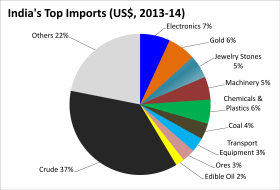Commodity value
In the field of economics, the commodity value of a good is its free market intrinsic value under optimal use conditions. In a free market, the commodity value of a good will be reflected by its price. For example, if an acre of land can yield a net of 100 dollars loss by lying fallow, 50 dollars gain by being planted with corn, and 100 dollars gain by being planted with wheat, then that acre's commodity value is 100 dollars; the farmer is assumed to put his land to best use. The price of a commodity fluctuates around its commodity value.[1]

Currency
A commodity value expressed as a price is determined by historical, social and cultural aspects of production and distribution.[2] Karl Marx described price as the money-name for the labour realised in a commodity.[3] A commodity value is dependent on its utility.[4]
Commodity value is of particular significance in the study of currency. For example, the commodity value of a coin is the value of the metal of which it is made. Gold and silver coins have a high commodity value, whereas fiat coins such as modern day quarters have a low commodity value. This is of particular historical relevance when analyzed in light of Gresham's Law.
Because money becomes valuable not due to its substance, that is, its commodity value, but rather because of its performance, currencies tend to become token.[5]
Debt
Asset backed debt has a commodity value equal to the price of the collateral; a loan backed by a house has a commodity value equal to the free market price of the house. Non-collateralized debt, on the other hand, does not have a commodity value; it is valuable only insofar as it is repaid.
Investment
Commodity value is an important consideration in hedging against inflation. Whereas fiat currencies can devalue, often catastrophically, currencies with considerable commodity value are known to better maintain their value; a government can print as many fiat bills as it wants with relative ease, the same is not true of mining precious metals. This leads some investors to purchase goods and debts with high commodity value, which are inherently safer than those with low, or no commodity value, minimizing risk by sacrificing potential return.
See also
References
- Wu, Bingxin (2011). Consumption and Management: New Discovery and Applications. Elsevier. ISBN 9781908818072. Retrieved 4 January 2017.
- Sheumaker, Helen; Shirley Teresa Wajda (2008). Material Culture in America: Understanding Everyday Life. ABC-CLIO. p. 299. ISBN 9781576076477. Retrieved 3 January 2017.
- Marx, Karl (2007). Capital: A Critique of Political Economy - The Process of Capitalist Production. Cosimo, Inc. p. 114. ISBN 9781605200064. Retrieved 3 January 2017.
- Anderson, B. M. (1922). The Value of Money. Ludwig von Mises Institute. p. 15. ISBN 9781610162777. Retrieved 3 January 2017.
- Schoenberger, Erica (2014). Nature, Choice and Social Power. Routledge. p. 98. ISBN 1135051585. Retrieved 4 January 2017.